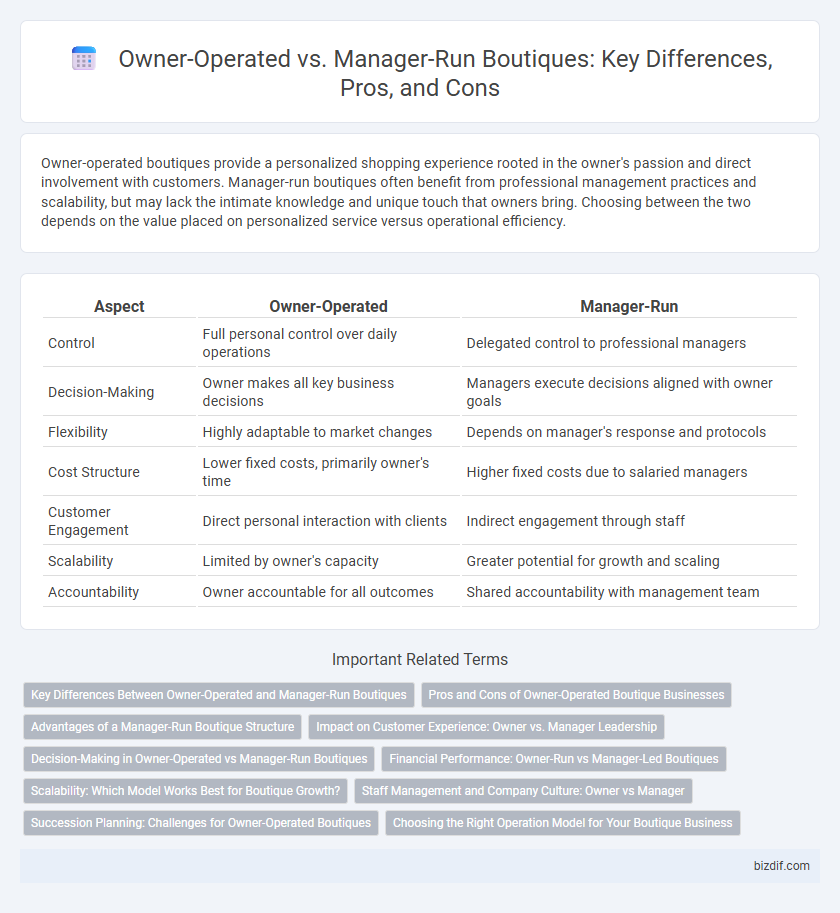Owner-operated boutiques provide a personalized shopping experience rooted in the owner's passion and direct involvement with customers. Manager-run boutiques often benefit from professional management practices and scalability, but may lack the intimate knowledge and unique touch that owners bring. Choosing between the two depends on the value placed on personalized service versus operational efficiency.
Table of Comparison
| Aspect | Owner-Operated | Manager-Run |
|---|---|---|
| Control | Full personal control over daily operations | Delegated control to professional managers |
| Decision-Making | Owner makes all key business decisions | Managers execute decisions aligned with owner goals |
| Flexibility | Highly adaptable to market changes | Depends on manager's response and protocols |
| Cost Structure | Lower fixed costs, primarily owner's time | Higher fixed costs due to salaried managers |
| Customer Engagement | Direct personal interaction with clients | Indirect engagement through staff |
| Scalability | Limited by owner's capacity | Greater potential for growth and scaling |
| Accountability | Owner accountable for all outcomes | Shared accountability with management team |
Key Differences Between Owner-Operated and Manager-Run Boutiques
Owner-operated boutiques feature direct involvement from the proprietor in daily operations, ensuring personalized customer service and brand authenticity. Manager-run boutiques rely on hired professionals to handle operational tasks, often resulting in scalable management but potential disconnect from the original vision. Key differences include decision-making control, operational flexibility, and the depth of owner engagement influencing customer experience and brand consistency.
Pros and Cons of Owner-Operated Boutique Businesses
Owner-operated boutique businesses offer personalized customer service and a unique brand vision, fostering strong community ties and direct quality control. However, they may face challenges such as limited scalability, high personal workload, and vulnerability to the owner's availability. Balancing hands-on management with business growth requires careful time management and resource allocation.
Advantages of a Manager-Run Boutique Structure
A manager-run boutique structure offers enhanced operational efficiency by delegating daily responsibilities to experienced professionals, allowing owners to focus on strategic growth and brand development. This setup improves consistency in customer service and staff management, leveraging specialized expertise to optimize boutique performance. Additionally, it enables scalability by establishing a clear leadership hierarchy, which supports expansion without overburdening the owner.
Impact on Customer Experience: Owner vs. Manager Leadership
Owner-operated boutiques often deliver a more personalized customer experience due to the owner's direct involvement and passion for the brand, leading to stronger customer loyalty and unique product curation. Manager-run boutiques may prioritize operational efficiency and standardized service protocols, which can result in consistent but less tailored interactions. Leadership style directly influences customer satisfaction through attention to detail, responsiveness, and the emotional connection formed with patrons.
Decision-Making in Owner-Operated vs Manager-Run Boutiques
Owner-operated boutiques benefit from agile decision-making, as the owner directly understands customer preferences and market shifts, enabling rapid adaptation. Manager-run boutiques often follow structured protocols, which can slow response times but provide consistent operations through specialized expertise. Decision-making in owner-operated shops tends to prioritize personal vision and customer experience, whereas manager-run establishments emphasize systematic management and scalability.
Financial Performance: Owner-Run vs Manager-Led Boutiques
Owner-operated boutiques often exhibit stronger financial performance due to the owner's direct involvement in daily operations, fostering personalized customer experiences and agile decision-making. Manager-led boutiques may benefit from professional management expertise but sometimes face challenges aligning operational decisions with the owner's vision, potentially affecting profitability. Studies indicate owner-run boutiques typically achieve higher revenue per square foot and improved cost control compared to their manager-managed counterparts.
Scalability: Which Model Works Best for Boutique Growth?
Owner-operated boutiques often excel in personalized customer service and brand authenticity, fostering strong local loyalty but face limitations in scalability due to time and resource constraints. Manager-run boutiques enable structured delegation and professional management systems, facilitating faster expansion and consistent operational standards across multiple locations. For boutique growth, a manager-run model typically offers greater scalability potential by leveraging experienced leadership and standardized processes.
Staff Management and Company Culture: Owner vs Manager
Owner-operated boutiques often cultivate a personalized company culture, as owners actively engage in staff management and daily operations, fostering strong team cohesion and direct communication. In contrast, manager-run boutiques rely on delegated leadership, which can streamline staff supervision but may introduce a layer of separation from the core company values and reduce personalized employee engagement. The difference in leadership approaches significantly influences staff motivation, accountability, and the overall atmosphere within the boutique.
Succession Planning: Challenges for Owner-Operated Boutiques
Owner-operated boutiques often face significant succession planning challenges due to the centralized control and unique vision held by the owner, which can create barriers to transferring leadership smoothly. Without a structured management team or clear delegation, these businesses risk operational disruptions and loss of brand identity during owner transitions. Developing a robust succession strategy is critical to preserving legacy, maintaining customer loyalty, and ensuring long-term business sustainability in owner-operated boutiques.
Choosing the Right Operation Model for Your Boutique Business
Selecting the right operation model for your boutique business hinges on your long-term goals, available resources, and desired level of involvement. Owner-operated boutiques benefit from personalized customer experiences and direct control over brand vision, while manager-run models support scalability and allow owners to prioritize strategic growth. Evaluating factors like operational expertise, financial investment, and the ability to maintain brand integrity ensures a successful boutique business tailored to market demands.
Owner-Operated vs Manager-Run Infographic

 bizdif.com
bizdif.com